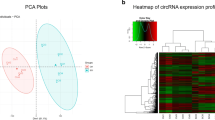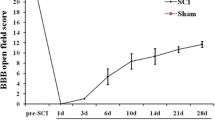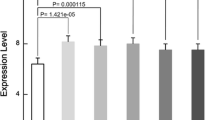Spinal cord injury (SCI) initiates a cascade of events and these responses to injury are likely to be mediated and reflected by changes in mRNA concentrations. As a step towards understanding the complex mechanisms underlying repair and regeneration after SCI, the gene expression pattern was examined 4.5 days after complete transection at T8-9 level of rat spinal cord. Improved subtractive hybridization was used to establish a subtracted cDNA library using cDNAs from normal rat spinal cord as driver and cDNAs from injured spinal cord as tester. By expressed sequence tag (EST) sequencing, we obtained 73 EST fragments from this library, representing 40 differentially expressed genes. Among them, 32 were known genes and 8 were novel genes. Functions of all annotated genes were scattered in almost every important field of cell life such as DNA repair, detoxification, mRNA quality control, cell cycle control, and signaling, which reflected the complexity of SCI and regeneration. Then we verified subtraction results with semiquantitative RT-PCR for eight genes. These analyses confirmed, to a large extent, that the subtraction results accurately reflected the molecular changes occurring at 4.5 days post-SCI. The current study identified a number of genes that may shed new light on SCI-related inflammation, neuroprotection, neurite-outgrowth, synaptogenesis, and astrogliosis. In conclusion, the identification of molecular changes using improved subtractive hybridization may lead to a better understanding of molecular mechanisms responsible for repair and regeneration after SCI.




Similar content being viewed by others
REFERENCES
Abel, T., Bhatt, R., and Maniatis, T. A. (1992). Drosophila CREB/ATF transcriptional activator binds to both fat body- and liver-specific regulatory elements. Genes Dev. 6(3):466–480.
Akopyants, N. S., Fradkov, A., Diatchenko, L., Hill, J. E., Siebert, P. D., Lukyanov, S. A., Sverdlov, E. D., and Berg, D. E. (1998). PCR-based subtractive hybridization and differences in gene content among strains of Helicobacter pylori. Proc. Natl. Acad. Sci. U S A 95(22):13108–13113.
Betsuyaku, T., Kadomatsu, K., Griffin, G. L., Muramatsu, T., and Senior, R. M. (2003). Increased basigin in bleomycin-induced lung injury. Am. J. Respir. Cell Mol. Biol. 28(5):600–606.
Caggiano, A. O., Zimber, M. P., Ganguly, A., Blight, A. R., and Gruskin, E. A. (2005). Chondroitinase ABCI improves locomotion and bladder function following contusion injury of the rat spinal cord. J. Neurotrauma 22(2):226–239.
Chen, M. S., Huber, A. B., van der Haar, M. E., Frank, M., Schnell, L., Spillmann, A. A., Christ, F., and Schwab, M. E. (2000). Nogo-A is a myelin-associated neurite outgrowth inhibitor and an antigen for monoclonal antibody IN-1. Nature 403:434–439
Chopp, M., Zhang, X. H., Li, Y., Wang, L., Chen, J., Lu, D., Lu, M., and Rosenblum, M. (2000). Spinal cord injury in rat: Treatment with bone marrow stromal cell transplantation. Neuroreport 11(13):3001–3005.
DeMattos, R. B., O’dell, M. A., Parsadanian, M., Taylor, J. W, Harmony, J. A., Bales, K. R., Paul, S. M., Aronow, B. J., and Holtzman, D. M. (2002). Clusterin promotes amyloid plaque formation and is critical for neuritic toxicity in a mouse model of Alzheimer's disease. Proc. Natl. Acad. Sci. USA 99(16):10843–10848.
Di Scala, F., Dupuis, L., Gaiddon, C., De. Tapia, M., Jokic, N., Gonzalez de Aguilar, J. L., Raul, J. S., Ludes, B., and Loeffler, J. P. (2005). Tissue specificity and regulation of the N-terminal diversity of reticulon 3. Biochem. J. 385(Pt 1):125–134.
Duguid, J. R., and Dinauer, M. C. (1990). Library subtraction of in vitro cDNA libraries to identify differentially expressed genes in scrapie infection. Nucleic Acids Res. 18(9):2789–2792.
Fan, Q. W., Yuasa, S., Kuno, N., Senda, T., Kobayashi, M., Muramatsu, T., and Kadomatsu, K. (1998). Expression of basigin, a member of the immunoglobulin superfamily, in the mouse central nervous system. Neurosci. Res. 30(1):53–63.
GrandPran, T., Nakamura, F., Vartanian, T., and Strittmatter, S. M. (2000). Identification of the Nogo inhibitor of axon regeneration as a Reticulon protein. Nature 403:439–444
Guth, L., Zhang, Z., DiProspero, N. A., Joubin, K., and Fitch, M. T. (1994). Spinal cord injury in the rat: treatment with bacterial lipopolysaccharide and indomethacin enhances cellular repair and locomotor function. Exp. Neurol. 126(1):76–87.
Heller, M., von der Ohe, M., Kleene, R., Mohajeri, M. H., and Schachner, M. (2003). The immunoglobulin-superfamily molecule basigin is a binding protein for oligomannosidic carbohydrates: An anti-idiotypic approach. J. Neurochem. 84(3):557–65.
He, W., Lu, Y., Qahwash, I., Hu, X. Y., Chang, A., and Yan, R. (2004). Eticulon family members modulate BACE1 activity and amyloid-beta peptide generation. Nat. Med. 10(9):959–965.
Ip, N. Y., Stitt, T. N., Tapley, P., Klein, R., Glass, D. J., Fandl, J., Greene, L. A., Barbacid, M., and Yancopoulos, G. D. (1993). Similarities and differences in the way neurotrophins interact with the Trk receptors in neuronal and nonneuronal cells. Neuron 10(2):137–149.
Iwahashi, J., Kawasaki, I., Kohara, Y., Gengyo-Ando, K., Mitani, S., Ohshima, Y., Hamada, N., Hara, K., Kashiwagi, T., and Toyoda, T. (2002). Caenorhabditis elegans reticulon interacts with RME-1 during embryogenesis. Biochem. Biophys. Res. Commun. 293(2):698–704.
Liu, L., Persson, J. K., Svensson, M., Aldskogius, H. (1998). Glial cell responses, complement, and clusterin in the central nervous system following dorsal root transection. Glia 23(3):221–238.
Mavrodi, D. V., Mavrodi, O. V., McSpadden-Gardener, B. B., Landa, B. B., Weller, D. M., and Thomashow, L. S. (2002). Identification of differences in genome content among phlD-positive Pseudomonas fluorescens strains by using PCR-based subtractive hybridization. Appl. Environ. Microbiol. 68(10):5170–5176.
Mitsumoto, Y., Watanabe, A., Miyauchi, T., Jimma, F., and Moriizumi, T. (2001). Stimulation of the regrowth of MPP+-damaged dopaminergic fibers by the treatment of mesencephalic cultures with basigin. J. Neural Transm. 108(10):1127–1134.
Namiki, J., and Tator, C. H. (1999). Cell proliferation and nestin expression in the ependyma of the adult rat spinal cord after injury. J. Neuropathol. Exp. Neurol. 58(5):489–498.
Nehme, C. L., Fayos, B. E., and Bartles, J. R. (1995). Distribution of the integral plasma membrane glycoprotein CE9 (MRC OX-47) among rat tissues and its induction by diverse stimuli of metabolic activation. Biochem. J. 310:693–698.
Oudega, M., and Marani, E. (1991). Expression of vimentin and glial fibrillary acidic protein in the developing rat spinal cord: An immunocytochemical study of the spinal cord glial system. J. Anat. 179:97–114.
Panagopoulos, I., Storlazzi, C. T., Fletcher, C. D. M., Fletcher, J. A., Nascimento, A., Domanski, H. A., Wejde, J., Brosjo, O., Rydholm, A., Isaksson, M., Mandahl, N., and Mertens, F. (2004). The chimeric FUS/CREB3L2 gene is specific for low-grade fibromyxoid sarcoma. Genes Chromosomes Cancer 40:218–228.
Pekny, M., Johansson, C. B., Eliasson, C., Stakeberg, J., Wallen, A., Perlmann, T., Lendahl, U., Betsholtz, C., Berthold, C. H., and Frisen, J. (1999). Abnormal reaction to central nervous system injury in mice lacking glial fibrillary acidic protein and vimentin. J. Cell. Biol. 145(3):503–514.
Perlson, E., Hanz, S., Ben-Yaakov, K., Segal-Ruder, Y., Seger, R., and Fainzilber, M. (2005). Vimentin-dependent spatial translocation of an activated MAP kinase in injured nerve. Neuron 45(5):715–726.
Schwab, M. E., and Bartholdi, D. (1996). Degeneration and regeneration of axons in the lesioned spinal cord. Physiol. Rev. 76(2):319–370.
Tanaka, H., Yamashita, T., Yachi, K., Fujiwara, T., Yoshikawa, H., and Tohyama, M. (2004). Cytoplasmic p21(Cip1/WAF1) enhances axonal regeneration and functional recovery after spinal cord injury in rats. Neuroscience 127(1):155–164.
Tornqvist, E., Liu, L., Aldskogius, H., Holst, H. V., and Svensson, M. (1996). Complement and clusterin in the injured nervous system. Neurobiol. Aging 17(5):695–705.
Toyama, Y., Maekawa, M., Kadomatsu, K., Miyauchi, T., Muramatsu, T., and Yuasa, S. (1999). Histological characterization of defective spermatogenesis in mice lacking the basigin gene. Anat. Histol. Embryol. 28(3):205–213.
Tyor, W. R., Avgeropoulos, N., Ohlandt, G., and Hogan, E. L. (2002). Treatment of spinal cord impact injury in the rat with transforming growth factor-beta. J. Neurol. Sci. 200(1–2):33–41.
Wildasin, K. (2004). Role of reticulon proteins in Alzheimer's disease. Lancet Neurol. 3(10):576.
Yoshida, M., Sugimoto, A., Ohshima, Y., and Takeshima, H. (2001). Important role of junctophilin in nematode motor function. Biochem. Biophys. Res. Commun. 289(1):234–239.
Zhang, K. H., Xiao, H. S., Lu, P. H., Shi, J., Li, G. D., Wang, Y. T., Han, S., Zhang, F. X., Lu, Y. J., Zhang, X., and Xu, X. M. (2004). Differential gene expression after complete spinal cord transection in adult rats: An analysis focused on a subchronic post-injury stage. Neuroscience 128(2):375–388.
Zhu, F., Yan, W., Zhan zl Chai, Y. B., Lu, F., Wang, Q., Peng, W. D., Yang, A. G., and Wang, C. J. (2000). Improved PCR-based subtractive hybridization strategy for cloning differentially expressed genes. Biotechniques 29(2):310–310.
ACKNOWLEDGMENTS
This subject was supported by the National Natural Science Foundation of China (30200094), Chinese National Key Project of Basic Research (001CB510206), and National Key Project of Chinese Sanitation Ministry (WKZ-2001-1-18).
Author information
Authors and Affiliations
Corresponding author
Rights and permissions
About this article
Cite this article
Ma, Z., Liu, T., Li, X. et al. Identification of Up-Regulated Genes After Complete Spinal Cord Transection in Adult Rats. Cell Mol Neurobiol 26, 277–288 (2006). https://doi.org/10.1007/s10571-006-9046-8
Received:
Accepted:
Published:
Issue Date:
DOI: https://doi.org/10.1007/s10571-006-9046-8




